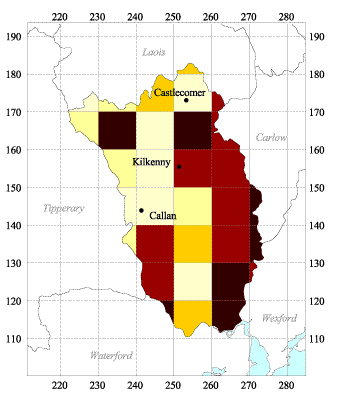What is Radon Gas?
What is Radon Gas ?
Radon is a naturally occurring Radio-Active Gas caused by the breakdown of Uranium which is found in underground rock.
It is a colourless and odourless gas which disperses in air but it has been shown to be Carcinogenic with risks of contracting lung cancer.
Radon Gas can percolate through the soil and gather under the floors of buildings. It can then seep through cracks/joints in floors or holes around pipework and accumulate in the structure. It may then become trapped in the building and can only be detected by specialist detection equipment.
What is the extent of the problem ?
It is only recently that Radon Gas has been identified as being a hazard to Public Health . Consequently the Radiological Protection Institute of Ireland (R P I I ) undertook a comprehensive survey of Radon in Irish Dwellings. Approximately 11,500 houses were surveyed nationally and the results suggest that approximately 7% of Houses have Radon Concentrations in excess of the Maximum Acceptable Limit .
In July 1999, based on the Survey results , the R P I I published a map 'Radon in Irish Buildings' which subdivided the country into a grid of squares ( 10km. x 10km.) . Squares were designated High Radon Areas where it was predicted that more than 10% of the houses located therein had excessive levels.
What is being done about it ?
The Building Regulations were altered in 1998 to deal with Radon . Consequently it is mandatory that all new houses be fitted with a means of extracting radon gas. This normally consists of a Radon Collection Sump located in the sub floor and piped through the external walls. Should Radon subsequently be found in High Levels then it can be extracted safely by providing a fan on the pipework.
However in High Radon areas it is legally required that a Radon Barrier be installed under the floor (similar to a standard damp proof membrane ) in addition to the Radon Sump.
How is County Kilkenny affected by all of this ?
The Radon Map of Kilkenny predicts that a significant portion of the County has Radon Levels above the National Base Level (200 Bq/m3). Consequently the R P I I have recently completed a further survey of approximately 85 houses in the County.
52 houses built between 1992 and 1997 that would normally not have radon preventive measures fitted and
33 houses built after July 1998 which should have both a standby radon sump and radon barrier fitted.
Radon concentrations above the national reference level (200 Bq/m3) were found in three homes built before 1998 (the highest radon concentration found was slightly over 400 Bq/m3) and three built after 1998 (the highest radon concentration found was approximately 1,550 Bq/m3.
What should I do?
If building a new house you are advised to fit both a Radon Sump and a Radon Barrier. All new Social and Affordable Houses erected by the Kilkenny County Council are so constructed.
If you are living in an older property and are concerned about the presence of Radon then you can arrange for your own individual survey. Radon Detectors can be placed in discreet locations in your dwelling and are available from
a) Radiological Protection Ireland
As part of the Government's Public Sector Reform Plan, the Government merged the Environmental Protection Agency (EPA) and the Radiological Protection Institute of Ireland (RPII)
https://www.epa.ie/radon/
http://www.epa.ie/radiation/
b) Radon Laboratory Services,
Carrick on Shannon Business Park,
Dublin Road,
Carrick on Shannon,
Co. Leitrim
Tel No: 078-20724
c) The Radon Centre,
Kitestown,
Crossabeg,
Co. Wexford.
Tel No: 053-20282
A Detection Kit costs in the region of €40 and is normally installed at a high level in a ground floor room. The detector is a small piece of equipment, about half the size of a domestic smoke alarm and can be placed e.g. on top of a press.
The Detection Kit is left in place for a period of three months after which the Detector is returned to the supplier for analysis. The entire process takes about four months and the results will determine if further action is required.
What Can I Do If My House Is Affected?
There are a range of measures that can be taken. In many cases improved ventilation will be the solution. In more extreme cases it may be necessary to provide a more detailed solution e.g. install fans / pressurised systems or install a sump under the floor with an extraction fan. There are a number of firms in Ireland now specialising in the field of Radon Gas Remediation and the R P I I are also available for specialist advice.
A copy of the 'Radon Map of Kilkenny' is attached below.


View Detailed Radon Map of Kilkenny (1Mb Jpeg)

 Kilkenny County Council
Kilkenny County Council
